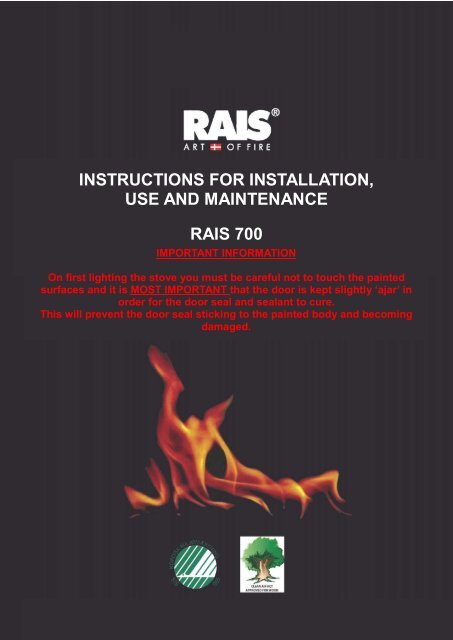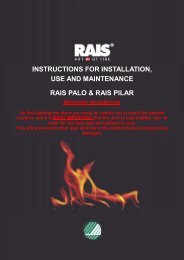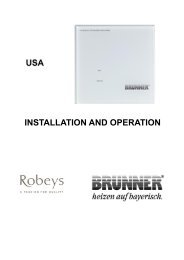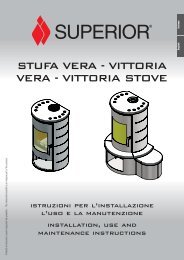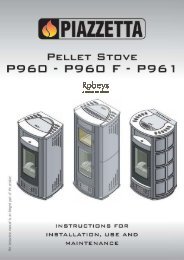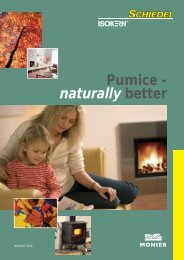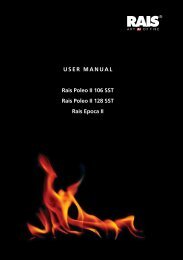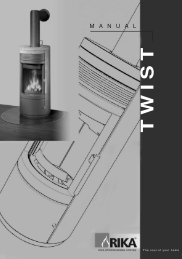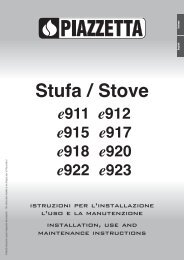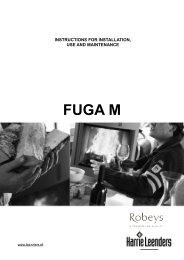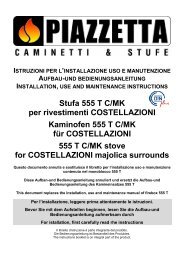instructions for installation, use and maintenance rais ... - Robeys Ltd
instructions for installation, use and maintenance rais ... - Robeys Ltd
instructions for installation, use and maintenance rais ... - Robeys Ltd
Create successful ePaper yourself
Turn your PDF publications into a flip-book with our unique Google optimized e-Paper software.
ENGLISH RAIS manual <strong>for</strong> Rais 700<br />
INSTRUCTIONS FOR INSTALLATION,<br />
USE AND MAINTENANCE<br />
RAIS 700<br />
IMPORTANT INFORMATION<br />
On first lighting the stove you must be careful not to touch the painted<br />
surfaces <strong>and</strong> it is MOST IMPORTANT that the door is kept slightly ‘ajar’ in<br />
order <strong>for</strong> the door seal <strong>and</strong> sealant to cure.<br />
This will prevent the door seal sticking to the painted body <strong>and</strong> becoming<br />
damaged.<br />
1
ENGLISH RAIS manual <strong>for</strong> Rais 700<br />
2
ENGLISH RAIS manual <strong>for</strong> Rais 700<br />
Rais 700<br />
Revision<br />
Date : 2011<br />
INTRODUCTION ………………………………………………………….. 4<br />
WARRANTY …………………………………………………….………….. 4<br />
SPECIFICATIONS ………………………………………………………….. 5<br />
INSTALLATION INSTRUCTIONS ………………………………….……… 6<br />
CONVECTION ……………………………………..……….………... 7<br />
CHIMNEY ……………………..…………………………….…………. 78<br />
FLUE OUTLET POSITIONS …………………………………………. 9<br />
HEARTH ……...………………………………………………………… 10<br />
QUICK GUIDE DRAWINGS …...……………………………………. 1112<br />
VENTILATION …………………………………………………………. 13<br />
COMBUSTION AIR SUPPLY ………………………………………… 14<br />
INSTALLATION ……………………………………………………….. 1415<br />
INSTALLATION DISTANCE …………………………………………. 1621<br />
COMMISSIONING AND HANDOVER ………………………………. 21<br />
OPERATING INSTRUCTIONS<br />
FUEL ……………………………………………………………………. 2223<br />
REGULATION OF COMBUSTION AIR …………………………….. 23<br />
USING THE WOOD BURNING STOVE ……………………………. 24<br />
ADJUSTMENT OF AIR DAMPER …………………………………... 24<br />
CONTROL ……………………………………………………………… 24<br />
FIRST USAGE …………………………………………………………. 24<br />
LIGHTING AND FUELLING ………………………………………….. 2627<br />
MAINTENANCE<br />
CLEANING AND CARE ………………………………………………. 27<br />
CHIMNEY CLEANING ………………………………………………… 28<br />
CLEANING THE FLUE WAYS ………………………………………. 29<br />
PROBLEM SOLVING …………….………………………………….. 30<br />
DO’S AND DON’TS ………………………………………………….. 31<br />
ACCESSORIES AND SPARE PARTS …………………………………... 32<br />
3
ENGLISH RAIS manual <strong>for</strong> Rais 700<br />
INTRODUCTION<br />
Thank you <strong>for</strong> purchasing a Rais wood burning stove.<br />
These appliances have been approved by HETAS as<br />
intermittent operating appliances <strong>for</strong> burning wood logs only.<br />
These appliances have been approved <strong>for</strong> <strong>use</strong> in Smokeless<br />
Zones.<br />
A Rais wood burning stove is more than just a heat source: it also shows that you<br />
care about design <strong>and</strong> quality in your home.<br />
To make the most of your wood burning stove it is important that you read the manual<br />
thoroughly be<strong>for</strong>e installing <strong>and</strong> using it.<br />
In the case of warranty coverage, <strong>and</strong> <strong>for</strong> general queries regarding your wood<br />
burning stove, it is important that you know the stove’s production number.<br />
We there<strong>for</strong>e recommend that you note down the number in the table below.<br />
The production number is located in the top of the convection box.<br />
WARRANTY<br />
Your Rais wood burning stove comes with a 5 year warranty.<br />
The warranty, however, does not cover heatinsulating materials, glass <strong>and</strong> seals.<br />
These are available to order from your local Rais dealer / stockist.<br />
Any alterations made to the stove will void the warranty.<br />
4
ENGLISH RAIS manual <strong>for</strong> Rais 700<br />
SPECIFICATIONS<br />
Rais 700<br />
RAIS 700<br />
Nominal output (kW): 5.2<br />
Nominal Min. / output Max. output (kW): (kW): 35.2<br />
7<br />
Min.<br />
Heating<br />
/ Max. output<br />
area (m<br />
(kW): 2 ): Ca. 360 7105<br />
Heating area (m 2 ):<br />
ca. 60 105<br />
Size, width/depth/height (mm): 825 / 485 / 535<br />
Size, width/depth/height (mm):<br />
Combustion chamber width/depth/height (mm). 562 / 289 / 300<br />
Combustion chamber width/depth/height (mm).<br />
Recommended amount of wood when fuelling (kg)<br />
1.8<br />
Recommended (Based on 2 amount 3 logs of of wood wood when approx. fuelling 25cm) (kg)<br />
1.8<br />
(Based on 2 3 logs of wood approx. 25cm)<br />
Min. uptake / Min. draught (Pascal): 12<br />
Min. uptake (Pascal):<br />
12<br />
Weight (kg):<br />
Weight (kg):<br />
125<br />
125<br />
Efficiency (%):<br />
Efficiency (%):<br />
80<br />
80<br />
Particles after NS3058/3059 (g/kg): 2.6<br />
Particles after NS3058/3059 (g/kg):<br />
2.6<br />
Dust measured according to Din+ (mg/Nm 3<br />
Dust measured according to Din+ (mg/Nm 3 ): 8<br />
):<br />
8<br />
Smoke gas mass flow (g/s): 5.1<br />
Smoke gas mass flow (g/s):<br />
5.1<br />
Smoke gas temperature (°C): 268<br />
Smoke gas temperature (°C):<br />
268<br />
Intermittent operation:<br />
Fuelling should be<br />
undertaken<br />
Intermittent operation:<br />
Fuelling should be undertaken<br />
within within 33 hours. hours<br />
5
ENGLISH RAIS manual <strong>for</strong> Rais 700<br />
INSTALLATION INSTRUCTIONS<br />
The following pages give <strong>instructions</strong> <strong>for</strong> the safe <strong>and</strong> proper <strong>installation</strong> of this heating<br />
appliance in the UK. These <strong>instructions</strong> cover the basic principles of <strong>installation</strong>,<br />
although some details may need slight modification to suit particular local site conditions.<br />
In all cases the <strong>installation</strong> must comply with current UK Building Regulations, Local<br />
Authority Byelaws <strong>and</strong> other specifications or regulations as they affect the <strong>installation</strong> of<br />
the stove.<br />
Please note that it is a legal requirement under Engl<strong>and</strong> <strong>and</strong> Wales Building Regulations<br />
that the <strong>installation</strong> of the stove is either carried out under local Authority Building<br />
Control approval or is installed by a Competent Person registered with a Government<br />
approved Competent Persons Scheme. HETAS operate such a scheme <strong>and</strong> a listing of<br />
their registered Competent Persons can be found on their website at www.hetas.co.uk.<br />
It should be noted that the current Building Regulations requirements are given in<br />
Approved Document J. These requirements may also be met by adopting the relevant<br />
recommendations given in British St<strong>and</strong>ards BS 8303, BS EN152871:2007.<br />
WARNING. Health <strong>and</strong> Safety Advice Notice.<br />
The <strong>installation</strong> of this heating appliance is governed by the Health <strong>and</strong> Safety at Work<br />
Act 1974. it is the responsibility of the installer to ensure that all requirements of this Act<br />
are met during the <strong>installation</strong> works. Attention is drawn in particular to the following:<br />
H<strong>and</strong>ling:<br />
The appliance is a heavy item <strong>and</strong> adequate facilities must be available<br />
<strong>for</strong> loading, unloading <strong>and</strong> site h<strong>and</strong>ling.<br />
Fire Cement: Some types of fire cement are caustic <strong>and</strong> should not be allowed to come<br />
into contact with the skin. Protective gloves should be worn when<br />
h<strong>and</strong>ling fire cement. In case of contact with the skin, wash immediately<br />
with plenty of water.<br />
Asbestos:<br />
Metal Parts:<br />
This stove contains no asbestos. If there is a possibility of disturbing any<br />
asbestos in the course of the <strong>installation</strong>, then please seek specialist<br />
guidance <strong>and</strong> <strong>use</strong> appropriate protective equipment.<br />
When installing or servicing this stove care should be taken to avoid the<br />
possibility of personal injury.<br />
Important Warning Preparatory Work <strong>and</strong> safety Checks:<br />
· This stove must not be installed into a chimney which serves any other heating<br />
appliance.<br />
· There must not be an extractor fan fitted in the same room as the stove, as this can<br />
ca<strong>use</strong> the stove to emit fumes into the room.<br />
· If this appliance is installed into an existing chimney, the chimney must first be<br />
swept <strong>and</strong> examined <strong>for</strong> soundness <strong>and</strong> suitability, be<strong>for</strong>e the appliance is installed<br />
(see also section headed ‘Chimney’).<br />
6
ENGLISH RAIS manual <strong>for</strong> Rais 700<br />
Convection<br />
Rais stoves are convection stoves. This means that the stove’s back <strong>and</strong> side panels are<br />
not overheated. Convection means that there is a circulation of air, which ensures that<br />
the heat is distributed more evenly throughout the entire room. The cold air is sucked in at<br />
the base of the stove <strong>and</strong> up through the convection channel, which runs along the<br />
stove’s combustion chamber. The heated air comes out at the top of the stove, which<br />
ensures a circulation of warm air throughout the room.<br />
The stoves are equipped with cool door h<strong>and</strong>les a Rais special feature which means<br />
you could almost do away with gloves. Be aware, however, that all exterior surfaces<br />
become hot during <strong>use</strong> so take extreme care.<br />
Chimney<br />
In order <strong>for</strong> the stove to per<strong>for</strong>m satisfactorily the chimney height must be sufficient to<br />
ensure an adequate draught of approximately 15 Pa so as to clear the products of<br />
combustion <strong>and</strong> prevent smoke problems into the room.<br />
NOTE: A chimney height of not less than 4.5 metres measured vertically from the outlet of<br />
the stove to the top of the chimney should be satisfactory. Alternatively the calculation<br />
procedure given in EN 133841 may be <strong>use</strong>d as the basis <strong>for</strong> deciding whether a<br />
particular chimney design will provide sufficient draught.<br />
The outlet from the chimney should be above the roof of the building in accordance with<br />
the provisions of Building Regulations Approved Document J.<br />
If <strong>installation</strong> is into an existing chimney then it must be sound <strong>and</strong> have no cracks or<br />
other faults which might allow fumes into the ho<strong>use</strong>. Older properties, especially, may<br />
have chimney faults or the cross section may be too large i.e. more than 230 mm x 230<br />
mm. Remedial action should be taken, if required, seeking expert advice, if necessary. If it<br />
is found necessary to line the chimney then a flue liner suitable <strong>for</strong> solid fuel must be <strong>use</strong>d<br />
in accordance with Building Regulations Approved Document J.<br />
Any existing chimney must be clear of obstruction <strong>and</strong> have been swept clean<br />
immediately be<strong>for</strong>e <strong>installation</strong> of the stove. If the stove is fitted in place of an open fire<br />
then the chimney should be swept one month after <strong>installation</strong> to clear any soot falls<br />
which may have occurred due to the difference in combustion between the stove <strong>and</strong> the<br />
open fire.<br />
If there is no existing chimney then any new system must be to the designation<br />
described above <strong>and</strong> in accordance with Building Regulations Approved Document J.<br />
A single wall metal fluepipe is suitable <strong>for</strong> connecting the stove to the chimney but is not<br />
suitable <strong>for</strong> <strong>use</strong> as the complete chimney. The chimney <strong>and</strong> connecting fluepipe must<br />
have a minimum diameter of 150 mm <strong>and</strong> its dimension should be not less than the size<br />
of the outlet socket of the stove.<br />
7
ENGLISH RAIS manual <strong>for</strong> Rais 700<br />
Any bend in the chimney or connecting fluepipe should not exceed 45°.<br />
90° bends should not be <strong>use</strong>d.<br />
Combustible material should not be located where the heat dissipating through the<br />
walls of fireplaces or flues could ignite it. There<strong>for</strong>e when installing the stove in the<br />
presence of combustible materials due account must be taken of the guidance on the<br />
separation of combustible material given in Building Regulations Approved Document<br />
J <strong>and</strong> also in these stove <strong>instructions</strong>.<br />
If it is found that there is excessive draught in the chimney then a draught stabiliser<br />
should be fitted. Fitting of a draught stabiliser will affect the requirement <strong>for</strong> the<br />
permanent air supply into the room in which the stove is fitted in accordance with<br />
Approved Document J (see also combustion air supply).<br />
Adequate provision e.g. easily accessible soot door or doors must be provided <strong>for</strong><br />
sweeping the chimney <strong>and</strong> connecting fluepipe where it is not intended <strong>for</strong> the<br />
chimney to be swept through the appliance.<br />
Chimney Fires<br />
If the chimney is thoroughly <strong>and</strong> regularly swept, chimney fires should not occur.<br />
However, if a chimney fire does occur turn off the stove immediately <strong>and</strong> isolate the<br />
mains electricity supply (if applicable), <strong>and</strong> tightly close the doors of the stove. This<br />
should ca<strong>use</strong> the chimney fire to go out. If the chimney fire does not go out when the<br />
above action is taken then the fire brigade should be called immediately. Do not relight<br />
the stove until the chimney <strong>and</strong> flue ways have been cleaned <strong>and</strong> examined by a<br />
professional.<br />
8
ENGLISH RAIS manual <strong>for</strong> Rais 700<br />
Flue Outlet Positions<br />
9
ENGLISH RAIS manual <strong>for</strong> Rais 700<br />
Hearth<br />
The hearth should be able to accommodate the weight of the stove <strong>and</strong> its<br />
chimney if the chimney is not independently supported. The weight of the stove is<br />
indicated in the brochure.<br />
The stove should preferably be installed on a noncombustible hearth of a size <strong>and</strong><br />
construction that is in accordance with the provisions of the current Building<br />
Regulations Approved Document J.<br />
The clearance distances to combustible material beneath, surrounding or upon the<br />
hearth <strong>and</strong> walls adjacent to the hearth should comply with the guidance on the<br />
separation of combustible material given in Building Regulations Approved<br />
Document J <strong>and</strong> also in these stove <strong>instructions</strong>.<br />
If the stove is to be installed on a combustible floor surface, it must be covered<br />
with a noncombustible material at least 12mm thick, in accordance with Building<br />
Regulations Approved Document J, to a distance of 30 cm in front of the stove <strong>and</strong><br />
15 cm to each side measuring from the door of the combustion chamber.<br />
10
ENGLISH RAIS manual <strong>for</strong> Rais 700<br />
11
ENGLISH RAIS manual <strong>for</strong> Rais 700<br />
12
ENGLISH RAIS manual <strong>for</strong> Rais 700<br />
Ventilation make the best possible <strong>use</strong> of the inserts.<br />
The stove is equipped with four convection air outlets, which can be connected with<br />
suitable air ducts to other rooms.<br />
Note, this is NOT a working drawing.<br />
13
ENGLISH RAIS manual <strong>for</strong> Rais 700<br />
Combustion air supply<br />
In order <strong>for</strong> the stove to per<strong>for</strong>m efficiently <strong>and</strong> safely there must be an adequate air<br />
supply into the room in which the stove is installed to provide combustion air. The<br />
provision of air supply to the stove must be in accordance with current Building<br />
Regulations Approved Document J. An opening window is not appropriate <strong>for</strong> this<br />
purpose.<br />
Installation<br />
It is prohibited to carry out unauthorised alterations to the stove.<br />
There must be plenty of fresh air in the room where the stove is being installed, in order to<br />
ensure proper combustion. Note that any mechanical exhaust ventilation e.g. an<br />
extraction hood is not permitted. Any air grilles must be placed in such a manner, that<br />
the air supply is not blocked.<br />
The stove is equipped with four convection air outlets, which may be connected with<br />
suitable air ducts to other rooms.<br />
Building Regulations Approved Document J gives specific guidance on the required<br />
permanent ventilation into the room <strong>for</strong> combustion air of solid fuel appliances.<br />
The floor structure must be able to carry the weight of the wood burning stove, as well as<br />
the weight of a chimney, if necessary.<br />
When you choose where to set up your RAIS wood burning stove, you should consider the<br />
heat distribution to the other rooms. This will enable you to get the best <strong>use</strong> out of your<br />
stove.<br />
The stove should be set up at a safe distance from inflammable materials.<br />
See the manufacturer's plate on the wood burning stove.<br />
Installation of stove:<br />
NOTE !<br />
A decision must be made concerning the positioning of the inlets <strong>and</strong> outlets of<br />
the convection system. Discolouration of the wall above the doors <strong>and</strong> the<br />
convection air outlets may occur due to convected hot air.<br />
RAIS cannot take responsibility <strong>for</strong> any building work or consequential damage.<br />
The stove should be inspected <strong>for</strong> defects at receipt.<br />
14
ENGLISH RAIS manual <strong>for</strong> Rais 700<br />
Lift the stove from the pallet to the place of <strong>installation</strong> on to a suitably protected floor.<br />
The stove can be mounted on the optional adjustable st<strong>and</strong> ( see page 29 ).<br />
These are available to order from your local Rais dealer / stockist.<br />
Using a spirit level against the door <strong>and</strong> body of the stove, ensure that the stove is<br />
perfectly level <strong>and</strong> make adjustments using the levelling bolts in the base.<br />
Remove the frame <strong>and</strong> door from the stove. Be careful not to damage the glass or<br />
paint.<br />
Seal the flue pipe on to the flue outlet using fire cement <strong>and</strong> self tapping screws <strong>and</strong><br />
connect to the chimney.<br />
Connect the convection air ducts, if required.<br />
Install air system manifold kit ( A ) to the pipe stub, if required ( optional ).<br />
The stove is now ready to be built in using either stud walls or solid walls.<br />
When the walls have been finished <strong>and</strong> decorated, the frame <strong>and</strong> door can be<br />
refitted. Remove all protective plastic <strong>and</strong> tape prior to commissioning.<br />
A<br />
A<br />
It is possible to order ‘made to measure’ frames.<br />
Contact your Rais dealer.<br />
15
ENGLISH RAIS manual <strong>for</strong> Rais 700<br />
Insulation ability such as Aqua panel ( coefficient of thermal conductivity 0.36 W/mk )<br />
or better. Please <strong>use</strong> metal stud.<br />
Insulate ceiling if<br />
necessary<br />
16
ENGLISH RAIS manual <strong>for</strong> Rais 700<br />
Insulate ceiling if<br />
necessary<br />
17
ENGLISH RAIS manual <strong>for</strong> Rais 700<br />
Insulate ceiling if<br />
necessary<br />
Distance to non<br />
combustible material<br />
50mm min<br />
Distance to non<br />
combustible material<br />
50mm min<br />
18
ENGLISH RAIS manual <strong>for</strong> Rais 700<br />
19
ENGLISH RAIS manual <strong>for</strong> Rais 700<br />
20
ENGLISH RAIS manual <strong>for</strong> Rais 700<br />
Installation distance in case of combustible wall<br />
To find out whether the wall next to where the stove is going to be installed is flammable,<br />
you should contact your building contractor or the local building authorities.<br />
The hearth should be able to accommodate the weight of the stove. The chimney must<br />
be independently supported by wall brackets or a ceiling support plate. The weight of the<br />
stove is indicated in the brochure.<br />
The stove should always be installed on a noncombustible hearth of a size <strong>and</strong><br />
construction that is in accordance with the provisions of the current UK Building<br />
Regulations Approved Document J.<br />
If the stove is to be installed on a wooden floor, it must be covered with a<br />
noncombustible material at least 12mm thick, in accordance with UK Building<br />
Regulations Approved Document J, to a distance of 300 mm in front of the stove <strong>and</strong><br />
150 mm to each side measuring from the door of the combustion chamber.<br />
The clearance distances to combustible material beneath, surrounding or upon the<br />
hearth <strong>and</strong> walls adjacent to the hearth should comply with the guidance on the<br />
separation of combustible material given in UK Building Regulations Approved<br />
Document J <strong>and</strong> also in these stove <strong>instructions</strong>.<br />
Commissioning <strong>and</strong> h<strong>and</strong>over<br />
Ensure all parts are fitted in accordance with the <strong>instructions</strong>.<br />
On completion of the <strong>installation</strong> allow a suitable period of time <strong>for</strong> any fire cement <strong>and</strong><br />
mortar to dry out, be<strong>for</strong>e lighting the stove. Once the stove is under fire check all seals<br />
<strong>for</strong> soundness <strong>and</strong> check that the flue is functioning correctly <strong>and</strong> that all products of<br />
combustion are vented safely to atmosphere via the chimney terminal.<br />
On completion of the <strong>installation</strong> <strong>and</strong> commissioning ensure that the operating<br />
<strong>instructions</strong> <strong>for</strong> the stove are left with the customer. Ensure to advise the customer on<br />
the correct <strong>use</strong> of the appliance <strong>and</strong> warn them to <strong>use</strong> only the recommended fuel <strong>for</strong> the<br />
stove.<br />
Advise the <strong>use</strong>r what to do should smoke or fumes be emitted from the stove. The<br />
customer should be warned to <strong>use</strong> a fireguard to BS 8423:2002 (Replaces BS 6539) in<br />
the presence of children, aged <strong>and</strong>/or infirm persons.<br />
CO Alarm<br />
Building regulations require that when ever a new or replacement fixed solid fuel or<br />
wood/biomass appliance is installed in a dwelling a carbon monoxide alarm must be<br />
fitted in the same room as the appliance. Further guidance on the <strong>installation</strong> of the<br />
carbon monoxide alarm is available in BS EN 50292:2002 <strong>and</strong> from the alarm<br />
manufacturer’s <strong>instructions</strong>.<br />
Provision of an alarm must not be considered a substitute <strong>for</strong> either installing the<br />
appliance correctly or ensuring regular servicing <strong>and</strong> <strong>maintenance</strong> of the appliance <strong>and</strong><br />
chimney system.<br />
21
ENGLISH RAIS manual <strong>for</strong> Rais 700<br />
OPERATING INSTRUCTIONS<br />
Please note that HETAS Appliance Approval only covers the <strong>use</strong> of dry seasoned wood<br />
logs on this appliance. HETAS Approval does not cover the <strong>use</strong> of other fuels either<br />
alone or mixed with the wood logs, nor does it cover <strong>instructions</strong> <strong>for</strong> the <strong>use</strong> of other<br />
fuels.<br />
Fuel<br />
The stove is designed <strong>and</strong> approved in accordance with EN 13240 <strong>and</strong> NS 3058 <strong>for</strong><br />
burning split, dried firewood. The firewood must have a water content of 1522% <strong>and</strong> its<br />
max. length should be the length of the combustion chamber minus 5060 mm.<br />
Stoking with wet firewood ca<strong>use</strong>s both soot, environmental pollution <strong>and</strong> bad fuel<br />
economy. Freshly cut wood contains approx. 5070% water <strong>and</strong> is thoroughly unsuitable<br />
<strong>for</strong> stoking. Allow at least 1 year of storage time <strong>for</strong> newly cut wood be<strong>for</strong>e using. Wood<br />
with a diameter of more than 100 mm should be split. Regardless of wood size, it should<br />
always have at least one surface area free of bark.<br />
We do not recommend stoking with painted, laminated or impregnated wood, wood with<br />
a synthetic surface, painted ref<strong>use</strong> wood, chipboard, plywood, domestic waste, paper<br />
briquettes <strong>and</strong> pit coal, as this will produce malodorous smoke, which could be<br />
poisonous.<br />
When firing with the abovementioned items <strong>and</strong> amounts larger than those<br />
recommended, the stove is subjected to a larger amount of heat, which results in a<br />
higher chimney temperature <strong>and</strong> lower efficiency. This can result in the stove <strong>and</strong><br />
chimney becoming damaged <strong>and</strong> would void the warranty.<br />
The calorific value of the firewood is closely connected to the moisture level.<br />
Moist firewood has a low heat value. The more water the wood contains, the more<br />
energy it takes <strong>for</strong> this water to vaporise, resulting in this energy being lost.<br />
ONLY USE RECOMMENDED FUELS<br />
The following table shows the calorific value of different types of wood, which have been<br />
stored <strong>for</strong> 2 years <strong>and</strong> which have a residual moisture of 15 17%.<br />
Wood Kg dry wood pr m 3 compared to beech/oak<br />
Hornbeam 640 110%<br />
Beech <strong>and</strong> oak 580 100%<br />
Ash 570 98%<br />
Maple 540 93%<br />
Birch 510 88%<br />
Mountain pine 480 83%<br />
Fir 390 67%<br />
Poplar 380 65%<br />
1kg of wood yields the same heat energy irrespective of wood type.<br />
1kg of beech merely takes up less space than 1kg of fir.<br />
22
ENGLISH RAIS manual <strong>for</strong> Rais 700<br />
Drying <strong>and</strong> storage<br />
Drying wood takes time: proper air drying takes approximately 2 years.<br />
Here are some tips:<br />
Store the wood sawn, split <strong>and</strong> stacked in an airy, sunny place, which is protected against<br />
rain (the south side of the ho<strong>use</strong> is particularly suitable).<br />
Store the firewood stacks at a h<strong>and</strong>'s breadth apart, as this ensures that the air flowing<br />
through takes the moisture with it. Avoid covering the firewood stacks with plastic, as this<br />
prevents the moisture from escaping. It is a good idea to bring the firewood into the ho<strong>use</strong><br />
23 days be<strong>for</strong>e you need it.<br />
Regulating the combustion air<br />
All RAIS stoves are equipped with a oneh<strong>and</strong>ed operating lever <strong>for</strong> regulating the damper.<br />
The stovespecific regulating mechanisms can be seen on the diagrams.<br />
Primary air is the combustion air added to the primary combustion zone, i.e. the bed of<br />
glowing embers. This air, which is cold, is only <strong>use</strong>d in the lighting stage. Secondary air is<br />
the air which is added in the gas combustion zone, i.e. air which contributes to the<br />
combustion of the pyrolysis gasses (preheated air, which is <strong>use</strong>d <strong>for</strong> the cleaner glass<br />
system <strong>and</strong> combustion). This air is sucked through the damper under the combustion<br />
chamber <strong>and</strong> is preheated through the side channels <strong>and</strong> then emitted as hot scavenging<br />
air onto the glass. The hot air rinses the glass <strong>and</strong> keeps it sootfree.<br />
The tertiary channel, which can be seen at the top of the combustion chamber towards the<br />
back, serves to combust the final gas residues.<br />
By setting the interval between position 1 <strong>and</strong> 2, the energy content in the firewood is <strong>use</strong>d<br />
optimally, as there is oxygen <strong>for</strong> combustion <strong>and</strong> <strong>for</strong> the burning of the pyrolysis gasses.<br />
When the flames are a clear yellow the damper has been set correctly. Finding the correct<br />
position comes with time after you have <strong>use</strong>d <strong>for</strong> stove <strong>for</strong> a while.<br />
It is not recommended that you turn it down completely. A mistake commonly made is<br />
shutting the damper too early beca<strong>use</strong> it feels too hot. This results in dark smoke emanating<br />
from the chimney <strong>and</strong> in the calorific value of the firewood not being <strong>use</strong>d to its fullest.<br />
Room ventilation <strong>and</strong> stoves<br />
There must not be an extractor fan fitted in the same room as the stove as this can ca<strong>use</strong><br />
the stove to emit smoke <strong>and</strong> fumes into the room.<br />
The stove requires a permanent <strong>and</strong> adequate air supply in order <strong>for</strong> it to operate safely <strong>and</strong><br />
efficiently.<br />
In accordance with current Building Regulations the installer may have fitted a permanent air<br />
supply vent into the room in which the stove is installed to provide combustion air. This air<br />
vent should not under any circumstances be shut off or sealed.<br />
CO Alarm<br />
Your installer should have fitted a CO alarm in the same room as the appliance. If the alarm<br />
sounds unexpectedly, follow the <strong>instructions</strong> given under “Important Warning Note” on<br />
page 23.<br />
23
ENGLISH RAIS manual <strong>for</strong> Rais 700<br />
Using the wood burning stove<br />
Adjustment of the air damper the damper has 3 settings<br />
Position 1<br />
The damper is almost closed meaning that there is a minimal air<br />
intake.<br />
Position 2<br />
Pull the lever until the first click. This position gives full secondary<br />
air.<br />
During normal <strong>use</strong> the lever is set between position 1 <strong>and</strong> 2.<br />
When the flames are clear <strong>and</strong> yellow, the damper is set<br />
correctly, i.e. resulting in a slow / optimal burning.<br />
Position 3<br />
Pull the lever until the next click.<br />
The air damper is completely open <strong>and</strong> gives full primary <strong>and</strong> secondary air. This<br />
position is <strong>for</strong> the lighting stage <strong>and</strong> is not <strong>use</strong>d under normal operation.<br />
Control<br />
If the ash is white <strong>and</strong> the walls in the combustion chamber are soot free after the stove<br />
has been <strong>use</strong>d, the air regulation was set correctly <strong>and</strong> the wood was sufficiently dry.<br />
First usage<br />
A careful start pays off. Start with a small fire, so that the wood burning stove can get<br />
accustomed to the high temperature. This gives the best start <strong>and</strong> any damage is<br />
avoided.<br />
Be aware that a strange but harmless odour <strong>and</strong> smoke concoction may emanate from<br />
the surface of the stove, the first time you fire up. This is beca<strong>use</strong> the paint <strong>and</strong><br />
materials need to harden. The odour disappears quickly, but you should check the<br />
ventilation <strong>and</strong> draught, if possible. See also, the IMPORTANT warning notice below<br />
about persistent fumes.<br />
During this process you must be careful not to touch the painted surfaces, it is<br />
recommended that you regularly open <strong>and</strong> close the door to prevent the door seal from<br />
sticking.<br />
The stove may also produce "clicking noises" during heating <strong>and</strong> cooling, ca<strong>use</strong>d by the<br />
large temperature differences which the material is subjected to.<br />
Never <strong>use</strong> any type of liquid fuel <strong>for</strong> kindling or maintaining the fire. You could be at risk<br />
of explosion.<br />
The stove gets very hot when in <strong>use</strong>, always wear protective gloves when tending the<br />
stove.<br />
If the stove has not been <strong>use</strong>d <strong>for</strong> a while, follow the steps as if you were using it <strong>for</strong> the<br />
first time.<br />
24
ENGLISH RAIS manual <strong>for</strong> Rais 700<br />
Be<strong>for</strong>e lighting the stove check with the installer that the <strong>installation</strong> work <strong>and</strong><br />
commissioning checks described above have been carried out correctly <strong>and</strong> that the<br />
chimney has been swept clean, is sound <strong>and</strong> free from any obstructions. As part of the<br />
stoves’ commissioning <strong>and</strong> h<strong>and</strong>over the installer should have shown you how to<br />
operate the stove correctly.<br />
IMPORTANT Warning Note!<br />
Properly installed, operated <strong>and</strong> maintained this appliance will not emit fumes into the<br />
dwelling. Occasional fumes from deashing <strong>and</strong> refuelling may occur.<br />
However, persistent fume emission is potentially dangerous <strong>and</strong> must not be tolerated.<br />
If fume emission does persist, the following immediate actions should be taken:<br />
(a) Open doors <strong>and</strong> windows to ventilate the room <strong>and</strong> then leave the premises.<br />
(b) Let the fire go out.<br />
(c) Check <strong>for</strong> flue or chimney blockage, <strong>and</strong> clean if required.<br />
(d) Do not attempt to relight the fire until the ca<strong>use</strong> of the fume emission has been<br />
identified <strong>and</strong> corrected. If necessary seek expert advice.<br />
The most common ca<strong>use</strong> of flue emission is flue way or chimney blockage.<br />
For your own safety these must be kept clean at all times.<br />
IMPORTANT Warning Note!<br />
Do not <strong>use</strong> an aerosol spray on or near the stove when it is alight.<br />
IMPORTANT Safety advice!<br />
When using the stove in situations where children, aged <strong>and</strong>/or infirm persons are<br />
present a fireguard must be <strong>use</strong>d to prevent accidental contact with the stove. The<br />
fireguard should be manufactured in accordance with BS 8423:2002 (Replaces BS<br />
6539).<br />
25
ENGLISH RAIS manual <strong>for</strong> Rais 700<br />
Lighting <strong>and</strong> fuelling<br />
To light the stove, <strong>use</strong> alcohol briquettes or<br />
similar, as well as approximately 2kg of<br />
firewood, split into kindling sticks. Set the air<br />
damper to the fully open position.<br />
Tips be<strong>for</strong>e firing up:<br />
Open a door or window close to the wood<br />
burning stove.<br />
If there is ‘storm’ in the stove coming from the<br />
chimney it is advisable to place a screwed up<br />
piece of newspaper between the upper baffle<br />
plate <strong>and</strong> the chimney. Light the paper <strong>and</strong><br />
wait until you hear a ‘rumbling’ noise in the<br />
chimney. This means that there is definitely a<br />
draught in the chimney <strong>and</strong> you should avoid<br />
smoke coming back into the room.<br />
Light the fire <strong>and</strong> shut the<br />
door, leave the door ajar<br />
approximately 1015mm.<br />
26
ENGLISH RAIS manual <strong>for</strong> Rais 700<br />
When the flames are clear, after approximately 510<br />
minutes, close the door.<br />
Damper see adjustment of the damper.<br />
After approximately 1020 minutes, when you have a<br />
good bed of glowing embers, add 23 pieces of wood.<br />
Leave the door ajar until the fire has caught properly,<br />
then close the door.<br />
Damper see adjustment of the damper.<br />
After approximately 5 minutes, or when the flames are<br />
clear <strong>and</strong> stable, close the damper gradually.<br />
It is recommended to have a layer of approximately<br />
20mm, as it has an insulating effect.<br />
NOTE!<br />
During operation the<br />
door should always<br />
remain closed.<br />
27
ENGLISH RAIS manual <strong>for</strong> Rais 700<br />
MAINTENANCE<br />
Cleaning <strong>and</strong> care<br />
The wood burning stove <strong>and</strong> the chimney must be serviced by a chimney sweep twice a<br />
year.<br />
During cleaning <strong>and</strong> care, the stove must be cold.<br />
If the glass is sooty:<br />
Moisten a piece of paper or newspaper, dip it in the ash, <strong>and</strong> rub the sooty glass with it.<br />
Now rub with a dry piece of paper <strong>and</strong> the glass will become clean.<br />
As an alternative you can <strong>use</strong> glass cleaner, which you can buy from you RAIS<br />
distributor.<br />
Clean the exterior with a dry sponge or a soft brush.<br />
Cleaning the combustion chamber:<br />
Scrape/shovel the ash out <strong>and</strong> store it in a nonflammable container until it has cooled<br />
down. You can dispose of ash with your normal ho<strong>use</strong>hold waste or recycle on the<br />
garden.<br />
REMEMBER!!<br />
Never remove all the ashes from the combustion chamber the wood will burn at its best<br />
with a layer of ashes of approx. 20 mm.<br />
Prolonged periods of non<strong>use</strong>:<br />
If the stove is to be left un<strong>use</strong>d <strong>for</strong> a prolonged period of time then it should be given a<br />
thorough clean to remove ash <strong>and</strong> unburned fuel residues. To enable a good flow of air<br />
through the appliance to reduce condensation <strong>and</strong> subsequent damage, leave the air<br />
controls fully open.<br />
Prior to a new heating season, it should be checked that the chimney <strong>and</strong> flue pipe<br />
connector are not blocked.<br />
Chimney cleaning<br />
The chimney should be swept at least twice a year. It is important that the flue connection<br />
<strong>and</strong> chimney are swept prior to lighting up after a prolonged shutdown period.<br />
If the stove is fitted in place of an open fire then the chimney will require sweeping after a<br />
month of continuous operation. This is a precaution to ensure that any “softer” deposits left<br />
from the open fire usage have not been loosened by the higher flue temperatures generated<br />
by the closed stove.<br />
In situations where it is not possible to sweep through the stove the installer will have provided<br />
alternative means, such as a soot door. After sweeping the chimney the stove flue<br />
outlet <strong>and</strong> the flue pipe connecting the stove to the chimney must be cleaned with a flue<br />
brush.<br />
28
ENGLISH RAIS manual <strong>for</strong> Rais 700<br />
Cleaning the flue ways<br />
The flue ways consist of a baffle plate <strong>and</strong> a smoke<br />
conductor above. These parts are screwed together.<br />
Both parts are made of Vermiculite.<br />
H<strong>and</strong>le these parts carefully.<br />
Lift the baffle plate a little <strong>and</strong> push towards one of the<br />
sides.<br />
Remove the baffle plate by lifting it upwards <strong>and</strong> tilting on<br />
it’s end.<br />
Gently take out the baffle plate.<br />
Now there is a clear view of the smoke exit.<br />
Remove any dirt / dust <strong>and</strong> put the parts back in, in<br />
reverse order.<br />
NB<br />
Make sure that the baffle plates are level with the<br />
hole in the back of the stove.<br />
29
ENGLISH RAIS manual <strong>for</strong> Rais 700<br />
Problem solving<br />
Smoke spillage around door:<br />
could be due to too low draught in the chimney 22 Pa, draught control regulator should be installed.<br />
A stove burning too weakly could be ca<strong>use</strong>d by:<br />
too little firewood<br />
too little air supply <strong>for</strong> the room ventilation<br />
dirty smoke channels<br />
leaking chimney<br />
leakage between chimney <strong>and</strong> flue<br />
If your stove continues to malfunction, we recommend that you contact your RAIS<br />
distributor or chimney sweep.<br />
IMPORTANT!!<br />
To ensure safe burning there must be clear yellow flames or clear embers at all times. The<br />
firewood should not be smouldering. There<strong>for</strong>e, you should never completely cut off the air<br />
supply.<br />
WARNING!!<br />
In case of chimney fire:<br />
shut off all air supply on the wood burning stove<br />
contact the fire services<br />
never attempt to put out fire with water!<br />
afterwards, you should ask your chimney sweep to check the stove <strong>and</strong> chimney<br />
30
ENGLISH RAIS manual <strong>for</strong> Rais 700<br />
DO’S AND DON’TS<br />
Do’s<br />
· Sweep the chimney / flue twice a year.<br />
· Service the appliance at least once a year<br />
· Dry, burn dry wood only. Use a moisture meter if unsure.<br />
· Spares, only <strong>use</strong> genuine Rais spare parts<br />
· Contact your dealer if you are unsure about the operation of your stove.<br />
· Line <strong>and</strong> insulate the chimney.<br />
· Use a qualified installer ( HETAS ) or building control.<br />
· Spend time with your stove get to know how your stove <strong>and</strong> chimney<br />
works.<br />
Don’ts<br />
· Overload your stove with wood.<br />
· Overfire, allow your stove to get too hot. Use a stove thermometer.<br />
· Burn poor quality fuel painted / treated wood.<br />
· Slowburn this can damage your stove <strong>and</strong> / or chimney please take<br />
advice from an expert first.<br />
· Closedown too soon never load your stove <strong>and</strong> close down the air supply <br />
always burn off the gasses first seek advice if in doubt.<br />
31
ENGLISH RAIS manual <strong>for</strong> Rais 700<br />
ACCESSORIES AND SPARE PARTS<br />
If spare parts other than those recommended by Rais are <strong>use</strong>d, the warranty is voided.<br />
7090501MON<br />
St<strong>and</strong><br />
7090506 Telescopic support<br />
7091790 Air system manifold kit<br />
7091301SV<br />
Special adaptor<br />
70914Spec<br />
Special frame<br />
Spare parts are available to order from your Rais dealer / stockist.<br />
7091401SORT<br />
Complete cover<br />
7092090 Steel door<br />
7091090 Glass door<br />
7092200 Fire brick set<br />
7090990 Air damper<br />
7090101MON<br />
Convection box<br />
7095500 Seal set<br />
32
ENGLISH RAIS manual <strong>for</strong> Rais 700<br />
33
ENGLISH RAIS manual <strong>for</strong> Rais 700<br />
U K Distributor.<br />
<strong>Robeys</strong> <strong>Ltd</strong>.<br />
Riverside, Goods Road, Belper,<br />
Derbyshire, Engl<strong>and</strong>. DE56 1UU<br />
Tel: 01773 820940 Fax: 01773 820477<br />
E Mail: info@robeys.co.uk<br />
www.robeys.co.uk<br />
June 2011<br />
34


